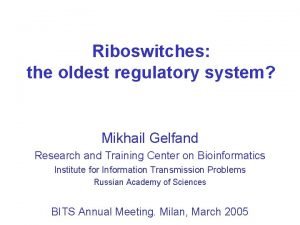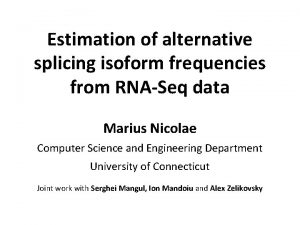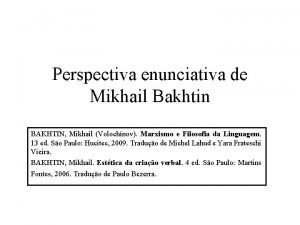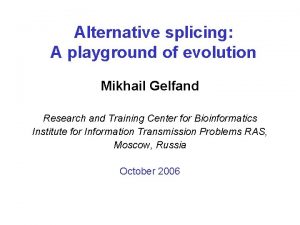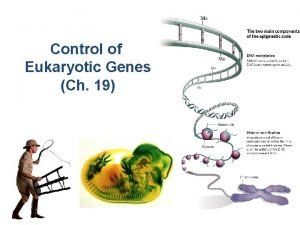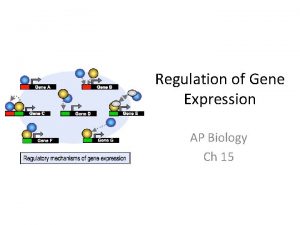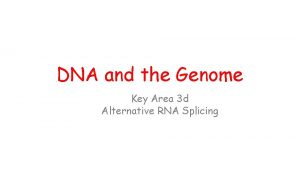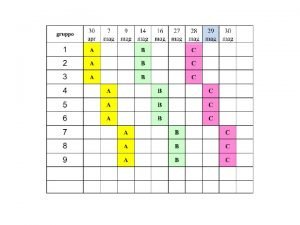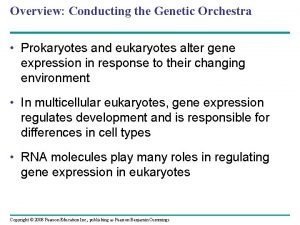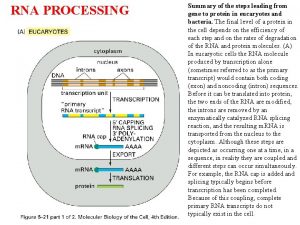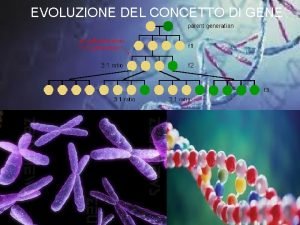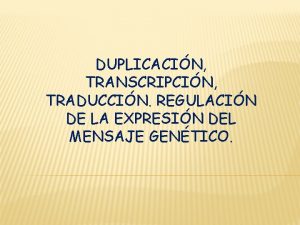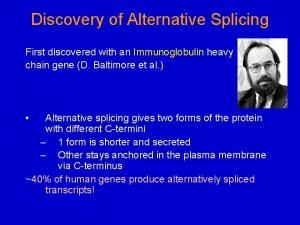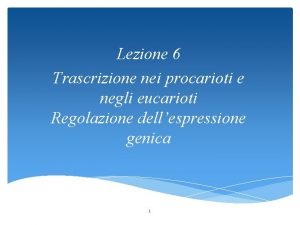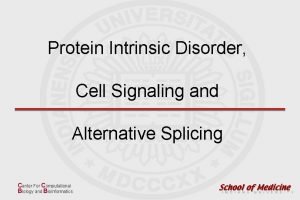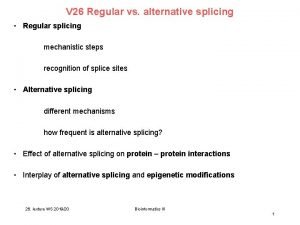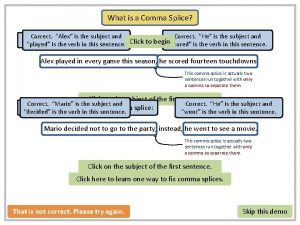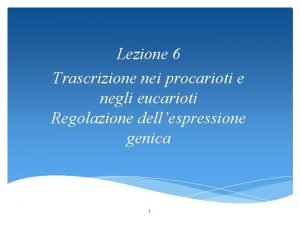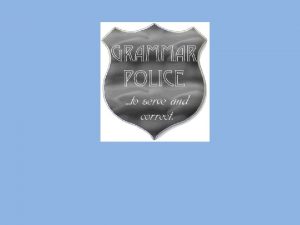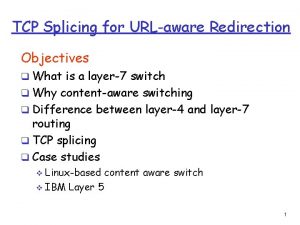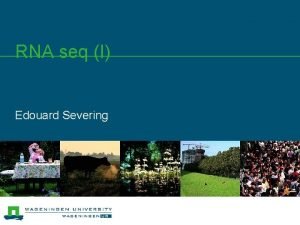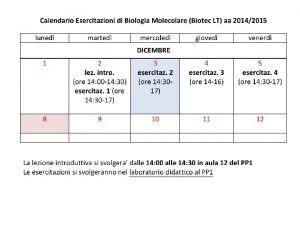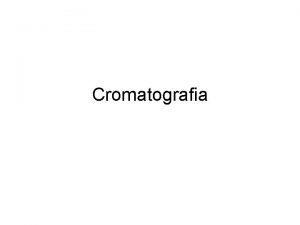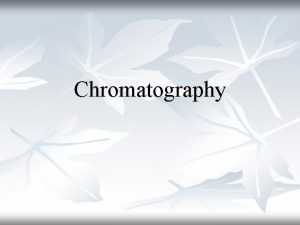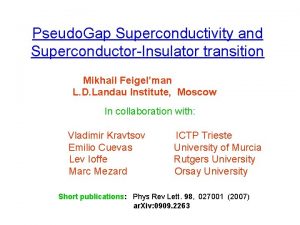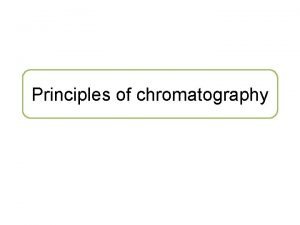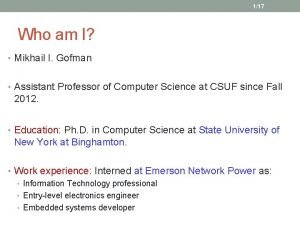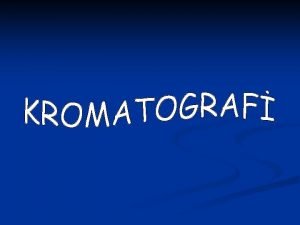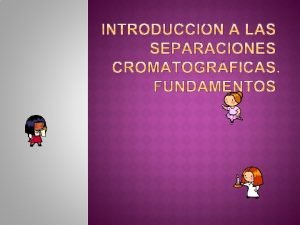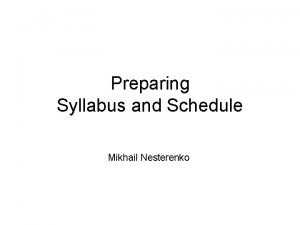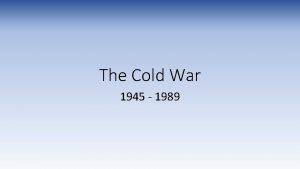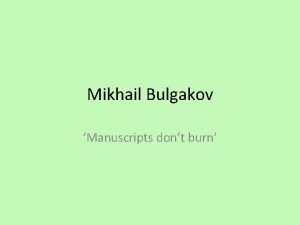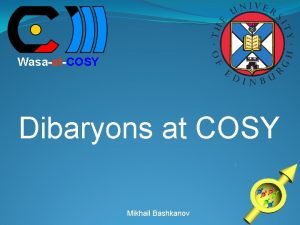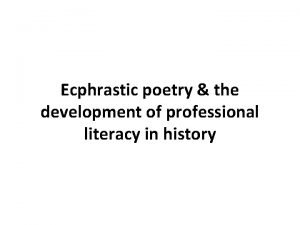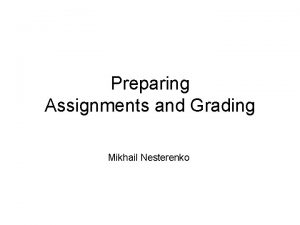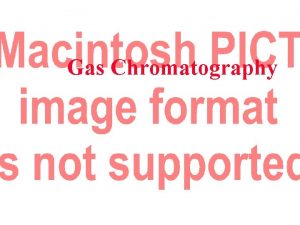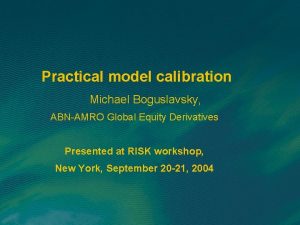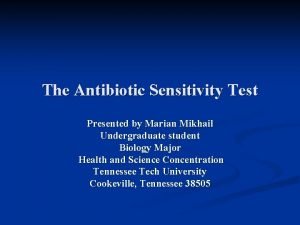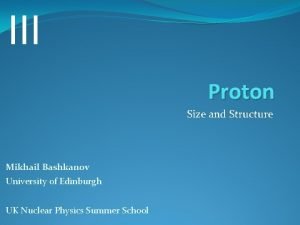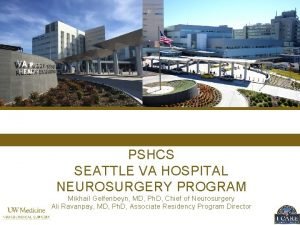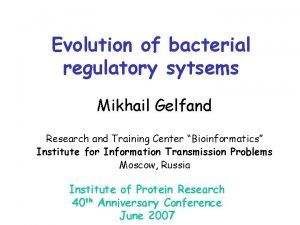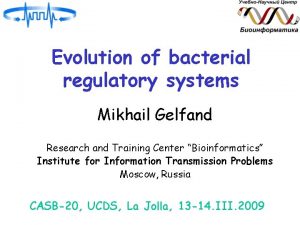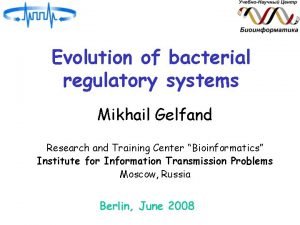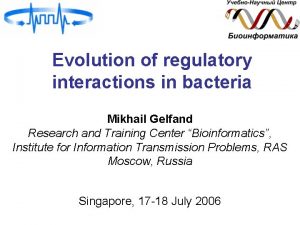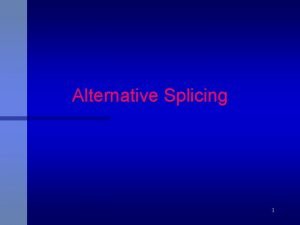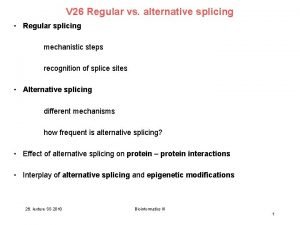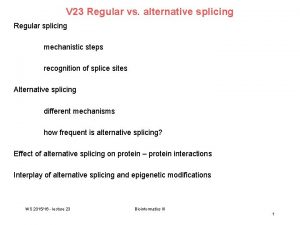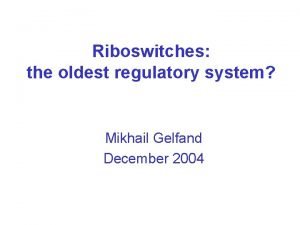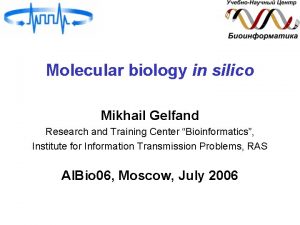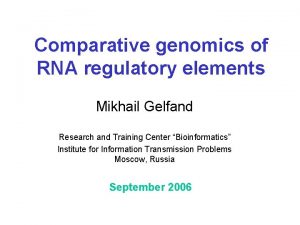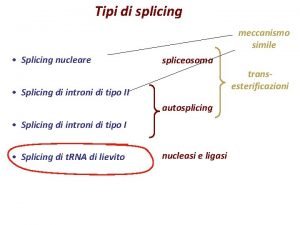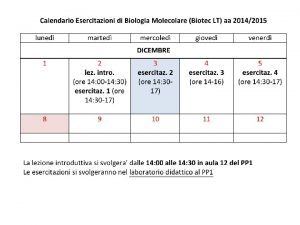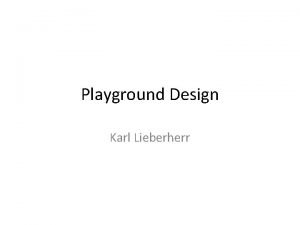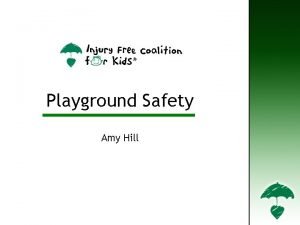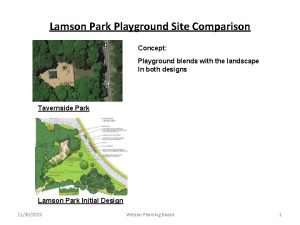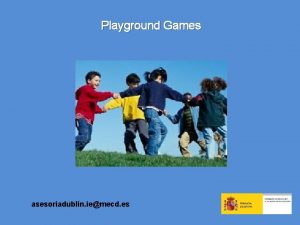Alternative splicing A playground of evolution Mikhail Gelfand
















































- Slides: 48

Alternative splicing: A playground of evolution Mikhail Gelfand Institute for Information Transmission Problems, RAS May 2004

Alternative splicing of human (and mouse) genes

• Alternative splicing of orthologous human and mouse genes • Sequence divergence in alternative and constitutive regions • Evolution of splicing sites • Alternative splicing and protein structure

Data • known alternative splicing – HASDB (human, ESTs+m. RNAs) – ASMam. DB (mouse, m. RNAs+genes) • additional variants – Uni. Gene (human and mouse EST clusters) • complete genes and genomic DNA – Gen. Bank (full-length mouse genes) – human genome

Methods • Direct comparison of EST-derived alternatives difficult because of uneven coverage. • Instead, align alternative isoforms from one species to the genomic DNA of other species. • If alignable (complete exon or part of exon, no significant loss of similarity, no in-frame stops, conserve splicing sites), then conserved. • This is an upper estimate on conservation: an isoform may be non-functional for other reasons (e. g. disruption of regulatory sites). • Cannot analyze skipped exons.

Tools • TBLASTN (initial identification of orthologs: m. RNAs against genomic DNA) • BLASTN (human m. RNAs against genome) • Pro-EST (spliced alignment, ESTs and m. RNA against genomic DNA) • Pro-Frame (spliced alignment, proteins against genomic DNA) – confirmation of orthology • same exon-intron structure • >70% identity over the entire protein length – analysis of conservation of alternative splicing • conservation of exons or parts of exons • conservation of sites

166 gene pairs Known alternative splicing: human 126 mouse 42 84 40 124

Elementary alternatives Cassette exon Alternative donor site Alternative acceptor site Retained intron

Human genes m. RNA EST cons. non-cons. Cassette exons 56 25 74 26 Alt. donors 18 7 16 10 Alt. acceptors 13 5 19 15 Retained introns 4 3 5 0 Total 96 30 114 51 Total genes 45 28 41 44 Conserved elementary alternatives: 69% (EST) - 76% (m. RNA) Genes with all isoforms conserved: 57 (45%)

Mouse genes m. RNA EST cons. non-cons. Cassette exons 70 5 39 9 Alt. donors 24 6 17 6 Alt. acceptors 15 6 16 9 Retained introns 8 7 10 4 Total 117 24 82 28 Total genes 68 22 30 26 Conserved elementary alternatives: 75% (EST) - 83% (m. RNA) Genes with all isoforms conserved: 79 (64%)

Real or aberrant non-conserved AS? • 24 -31% human vs. 17 -25% mouse elementary alternatives are not conserved • 55% human vs 36% mouse genes have at least one non-conserved variant • denser coverage of human genes by ESTs: – pick up rare (tissue- and stage-specific) => younger variants – pick up aberrant (non-functional) variants • 17 -24% m. RNA-derived elementary alternatives are non-conserved (compared to 25 -32% ESTderived ones)

smoothelin human-specific donor-site human common mouse-specific cassette exon

autoimmune regulator retained intron; downstream exons read in two frames human common mouse

Na/K-ATPase gamma subunit (Fxyd 2) alternative acceptor site within (inserted) intron common human mouse (deleted) intron

Mut. S homolog (DNA mismatch repair) dual donor/acceptor site human common

Modrek and Lee, 2003: • conserved skipped exons: – 98% constitutive – 98% major form – 28% minor form • inclusion level: – highly correlated – good predictor of conservation • Minor non-conserved form exons are not aberrant: – minor form exons are supported by multiple ESTs – 28% of minor form exons are upregulated in one specific tissue – 70% of tissue-specific exons are not conserved Thanaraj et al. , 2003: 61% (47 -86%) alternative splice junctions are conserved

• Alternative splicing of orthologous human and mouse genes • Sequence divergence in alternative and constitutive regions • Evolution of splicing sites • Alternative splicing and protein structure

“Contrary to our prediction, synonymous divergence between humans and non-human mammals was significantly higher in constitutive exons … Intriguingly, nonsynonymous divergence was marginally significantly higher in alternative exons” Iida and Akashi, 2000 Our preliminary observations: less synonymous, more non-synonymous divergence in alternative exons (human/mouse) => positive selection towards variability

279 proteins from Swiss. Prot+TREMBL with “varsplic” features constitutive alternative % alt. to all length all SNPs synonymous 199270 1126 576 (51%) 66054 368 167 (45%) 25% 22% benign damaging 401 (36%) 149 (13%) 141 (38%) 60 (16%) 26% 29% again, there is some evidence of positive selection towards diversity. This is not due to aberrant ESTs (only protein data are considered).

• Alternative splicing of orthologous human and mouse genes • Sequence divergence in alternative and constitutive regions • Evolution of splicing sites • Alternative splicing and protein structure

Alternative splicing in a multigene family: the MAGEA family of cancer/testis specific antigens • A locus at the X chromosome containing eleven recently duplicated genes: two subfamilies of four genes each and three single genes • One protein-coding exon, multiple different 5’UTR exons • Originates from retroposed spliced m. RNA • Mutations create new splicing sites or disrupt existing sites

Phylogenetic trees (protein-coding and upstream regions)

Expression data • pooled by organ/tissue; maximum recorded expression level retained • no data for MAGEA 10; MAGEA 3 and MAGEA 6 likely non-distinguishable • green: normal; brown: cancer

Simple genes with alternatives in exon 1 (MAGEA 1, MAGEA 5, MAGEA 3/6) MAGEA 1 1 1 b MAGEA 5 (normal placenta) 1 MAGEA 3 1 1 a 1 MAGEA 6 (testis, brain/medulla, cancer) 1 1 a

Two more genes of subfamily B: multiple isoforms of MAGEA 2 and a deletion in MAGEA 12 MAGEA 2 6 5 4 d 1 4 d 1 2 a 1 1 4 d 1 1 6 -5 MAGEA 12 1 -0 6 4 1 -0

Isoforms of subfamily A MAGEA 8 1 2 -1 3 1 MAGEA 9 (testis, no cancers) 2 1 MAGEA 10 4 a 4 a 4 c 1 2 d 1 MAGEA 11 4 b 1 1

Multiple duplications of the initial exon in MAGEA 4 (testis and cancers; brain/medulla; also common 3’ ESTs in placenta) 1 1 1 1 1

Chimaeric m. RNAs (splicing of readthrough transcripts) initial exon of MAGEA 10 exon in intergenic space exons of MAGEA 5 1 initial exon of MAGEA 12 exon in intergenic space exons of BC 013171

Other examples: • galactose-1 -phosphate uridylyltransferase + interleukin-11 receptor alpha chain (Magrangeas et al. , 1998) • P 2 Y 11 [receptor] + SSF 1 [nuclear protein] (Communi et al. , 2001) • Pr. P [Prion protein] + Dpl [prion-like protein Doppel] (Moore et al. , 1999) • cytochrome P 450 3 A: CYP 3 A 7 + two exons of a downstream pseudogene read in a different frame (Finta & Zaphiropoulos, 2000) • HHLA 1 + OC 90 [otoconin-90] (Kowalski et al. , 1999) • TRAX [translin-associated factor X] + DISC 1 [candidate schizophirenia gene] (Millar et al. , 2000) • Kua + UEV 1 [polyubiquination coeffector] (Thomson et al. , 2000) • FR + GAP [Rho GTPase activating protein] (Romani et al. , 2003) - ? • methyonyl t. RNA synthetase + advillin (Romani et al. , 2003) - ?

Birth of donor sites (new GT in alternative intial exon 5)

Birth of an acceptor site (new AG and poly. Y tract in MAGEA 8 -specific cassette exon 3)

Birth of an alternative donor site (enhanced match to the consensus (AG) in cassette exon 2)

Birth of an alternative acceptor site (enhanced poly. Y tract in cassette exon 4)

Disactivation of a donor site and birth of a new site (non-consensus G and new GT in major-isoform cassette exon 4)

Series of mutations sequentially activating downstream acceptor sites (mutated AG in exon 4)

• Alternative splicing of orthologous human and mouse genes • Sequence divergence in alternative and constitutive regions • Evolution of splicing sites • Alternative splicing and protein structure

Data • Alternatively spliced genes (proteins) from Swiss. Prot – human – mouse • Protein structures from PDB • Domains from Inter. Pro – – SMART Pfam Prosite etc.

Alternative splicing avoids disrupting domains (and non-domain units) Control: fix the domain structure; randomly place alternative regions

… and this is not simply a consequence of the (disputed) exon-domain correlation

Positive selection towards domain shuffling (not simply avoidance of disrupting domains)

Short (<50 aa) alternative splicing events within domains target protein functional sites c) FT positions affected FT positions unaffected Prosite patterns unaffected Expected Observed

An attempt of integration • AS is often young (as opposed to degenerating) • young AS isoforms are often minor and tissuespecific • … but still functional – although unique isoforms may be result of aberrant splicing • AS regions show evidence for positive selection – excess damaging SNPs – excess non-synonymous codon substitutions • MAGEA - not aberrant, because explainable by effects of mutations

What to do • Each isoform (alternative region) can be characterized: – by conservation (between genomes) – if conserved, by selection (positive vs negative) • human-mouse, also add rat – pattern of SNPs (synonymous, benign, damaging) – tissue-specificity • in particular, whether it is cancer-specific – degree of inclusion (major/minor) – functionality (for isoforms) • whether it generates a frameshift • how bad it is (the distance between the stop-codon and the last exon-exon junction)

What to expect (hypotheses) • Cancer-specific isoforms will be less functional and more often non-conserved • Non-conserved isoforms will contain a larger fraction of non-functional isoforms; and this may influence evolutionary conclusions • Still, after removal of non-functional isoforms, one should see positive selection in alternative regions (more non-synonymous substitutions compared to constant regions etc. ); especially in tissue-specific ones.

Plans • careful and detailed analysis of human-mouse -(rat)-((dog)) AS isoforms (human and mouse ESTs) • conservation of AS regulatory sites • mosquito-drosophila • more families of paralogs; add mouse data • AS of transcription factors and receptors

Acknowledgements • Discussions – – Vsevolod Makeev (Gos. NIIGenetika) Eugene Koonin (NCBI) Igor Rogozin (NCBI) Dmitry Petrov (Stanford) • Support – Ludwig Institute of Cancer Research – Howard Hughes Medical Institute

Authors • Andrei Mironov (Gos. NIIGenetika) – spliced alignment • Shamil Sunyaev (EMBL, now Harvard University Medical School) – protein structure • Vasily Ramensky (Institute of Molecular Biology) – SNPs • Irena Artamonova (Institute of Bioorganic Chemistry) – human/mouse comparison, MAGEA family • Dmitry Malko (Gos. NIIGenetika) – mosquito/drosophila comparison • Eugenia Kriventseva (EBI, now BASF) – protein structure • Ramil Nurtdinov (Moscow State University) – human/mouse comparison • Ekaterina Ermakova (Moscow State University) – evolution of alternative/constitutive regions

References Nurtdinov RN, Artamonova II, Mironov AA, Gelfand MS (2003) Low conservation of alternative splicing patterns in the human and mouse genomes. Human Molecular Genetics 12: 1313 -1320. Kriventseva EV, Koch I, Apweiler R, Vingron M, Bork P, Gelfand MS, Sunyaev S. (2003) Increase of functional diversity by alternative splicing. Trends in Genetics 19: 124 -128. Brudno M, Gelfand MS, Spengler S, Zorn M, Dubchak I, Conboy JG (2001) Computational analysis of candidate intron regulatory elements for tissue-specific alternative pre-m. RNA splicing. Nucleic Acids Research 29: 2338 -2348. Dralyuk I, Brudno M, Gelfand MS, Zorn M, Dubchak I (2000) ASDB: database of alternatively spliced genes. Nucleic Acids Research 28: 296 -297. Mironov AA, Fickett JW, Gelfand MS (1999). Frequent alternative splicing of human genes. Genome Research 9: 1288 -1293.
 Mikhail gelfand
Mikhail gelfand Mikhail gelfand
Mikhail gelfand Mikhail gelfand
Mikhail gelfand Mikhail gelfand
Mikhail gelfand Alternative rna splicing
Alternative rna splicing Alternative rna splicing
Alternative rna splicing Alternative splicing animation
Alternative splicing animation Proteine sr splicing
Proteine sr splicing Dna splicing
Dna splicing Eukaryotic splicing
Eukaryotic splicing Splicing alternativo
Splicing alternativo Splicing
Splicing Rna splicing
Rna splicing Rna polimerasi
Rna polimerasi Eukaryotic splicing
Eukaryotic splicing Rna splicing
Rna splicing Translation or transcription
Translation or transcription Dna splicing
Dna splicing What is comma splicing
What is comma splicing Differenze trascrizione eucarioti e procarioti
Differenze trascrizione eucarioti e procarioti When does a comma splice occur
When does a comma splice occur Tcp splicing
Tcp splicing Intron splicing
Intron splicing Trans splicing
Trans splicing What's a comma splice
What's a comma splice 1000 genome project
1000 genome project Mikhail tswett cromatografia
Mikhail tswett cromatografia Tswett
Tswett Mikhail feigelman
Mikhail feigelman Chromatography principles
Chromatography principles Mikhail bakhtin
Mikhail bakhtin Mikhail gofman
Mikhail gofman Karmda
Karmda Cyperm
Cyperm Mikhail tswett
Mikhail tswett Mikhail vasilyevich lomonosov
Mikhail vasilyevich lomonosov Mikhail nesterenko
Mikhail nesterenko Cold war mikhail gorbachev
Cold war mikhail gorbachev Manuscripts don t burn bulgakov
Manuscripts don t burn bulgakov Mikhail bashkanov
Mikhail bashkanov Cold war mikhail gorbachev
Cold war mikhail gorbachev Mikhail nesterenko
Mikhail nesterenko Mikhail tswett
Mikhail tswett Mikhail boguslavsky
Mikhail boguslavsky Marian mikhail
Marian mikhail Proton spin
Proton spin Dr mikhail gelfenbeyn
Dr mikhail gelfenbeyn Tswett chromatography
Tswett chromatography Rumus waktu retensi
Rumus waktu retensi
